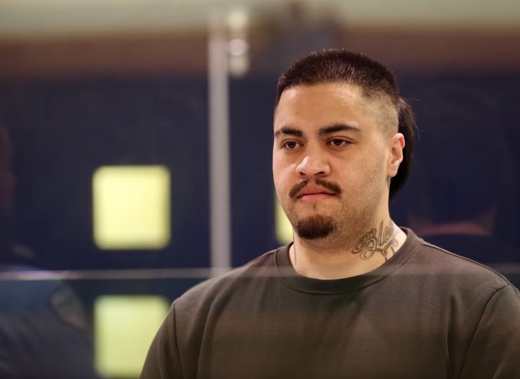
A jury has found Tipene Te Ahuru guilty of murdering his son Amaziah after a little under three hours of deliberation.
The unanimous verdict came on Tuesday afternoon after a week of evidence at his trial in the Auckland High Court.
Te Ahuru, 32, appeared stunned and a tear appeared on his face as the verdict was announced by the foreman. Amaziah’s mother Raurangi Richards, his former partner, watched from the public gallery.
Justice Jane Anderson set a sentencing date of July 10.
Amaziah suffered extensive injuries in a brief period while his mother, Te Ahuru’s then-partner, was doing the laundry on September 18, 2022.
The 3-month-old died after 11 days on life support as Te Ahuru gave incomplete and conflicting accounts of what happened.
Expert medical witnesses said the 3-month-old’s head injury was in all likelihood the result of abuse.
But, as Justice Jane Anderson said in her summing up of the case on Tuesday morning, this was a trial by jury, not a trial by experts.
There were also some differences in opinion between key medical experts, Justice Anderson said.
Forensic pathologist Dr Simon Stables, who did Amaziah’s autopsy, said he had suffered a subdural haematoma, a build-up of blood between the brain and its outermost covering or dura.
- Auckland father killed baby son while mother was out doing laundry - Crown
- Young Auckland couple's grim life no excuse for dad killing child - Crown
Between the dura and the brain’s surface were small and fragile blood vessels, Stables explained.
When a head came down suddenly on a surface, the brain lagged behind the skull and caused those vessels to snap like chewing gum suddenly stretched, he said.
Crown prosecutor Luke Radich asked Stables if a child could suffer a head injury like Amaziah’s from a short fall, as suggested by Te Ahuru’s lawyer Kelly-Ann Stoikoff.
“It can happen, but it’s incredibly rare,” the pathologist said.
The prosecution case is Te Ahuru forcibly struck his son or smashed him into another object, because the head injury was too severe to have been caused by a fall alone.

Tipene Te Ahuru, 32, appears in the High Court at Auckland on May 6, the first day of his murder trial. He is accused of inflicting fatal injuries on his baby boy Amaziah on September 18, 2022. Photo / Jason Oxenham
Paediatrician Dr Patrick Kelly was more definitive, saying there was “no other reasonable possibility” the injuries Amaziah suffered were anything other than the result of abusive head trauma.
Justice Anderson reminded the jury Stables and Kelly differed on whether another of Amaziah’s injuries, a broken arm, could have been caused by the infant’s arms flailing about.
The defence case is that the possibility cannot be excluded that Amaziah’s injuries were caused by Te Ahuru accidentally dropping his son.
Stoikoff, in her closing address, explained her client’s inconsistent and evolving accounts of what happened across several police interviews as a very human reaction of someone in a stressful situation trying to protect themselves and their family.
Justice Anderson told the jury that if they concluded Te Ahuru lied to police, that did not necessarily mean he had lied about other things.
People lie for any number of reasons, including panic or to protect themselves or their family, the judge said.
“It can be because they don’t trust the police.”
As part of their deliberations, juries are given a question trail to help aid their decision-making and guide them in evaluating the evidence.
The first and potentially last question for the jury in the Te Ahuru case is whether they were sure he intentionally shook, struck or slammed his son, or any combination thereof, on September 18, 2022.
If the answer is no, they find him not guilty.
If they find he did assault his son, their next question is whether it was a “substantial and operative cause” of the boy’s death 11 days later.
An answer of no to this question also results in an acquittal. If the answer is yes, the jury crosses the threshold for manslaughter and will be asked to consider the elements of the murder charge.
For the jury to reach a verdict of guilty on the murder charge, they would need to find he either intended to kill Amaziah or he had what Justice Anderson called “reckless intent”.
To find that he recklessly killed Amaziah and is guilty of murder via that route, the jury would need to be satisfied that 1) he intended to cause bodily harm that was more than minor in nature, 2) that he knew there was a real risk his actions could cause his son’s death, and 3) that he consciously ran the risk the child could die as a result of his actions.
Stoikoff earlier said the jury could not be sure of her client’s appreciation of risk in the moment.
Radich, in his opening address, said the Crown is not suggesting Te Ahuru planned the death of his child.
“Intent can and frequently is formed in an instant,” he said.
George Block is an Auckland-based reporter with a focus on police, the courts, prisons and defence. He joined the Herald in 2022 and has previously worked at Stuff in Auckland and the Otago Daily Times in Dunedin.
Take your Radio, Podcasts and Music with you









